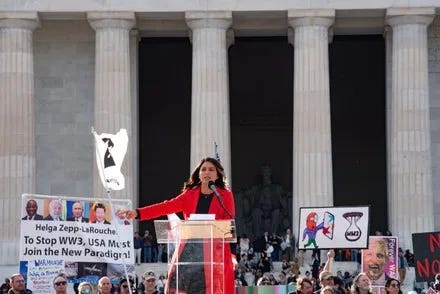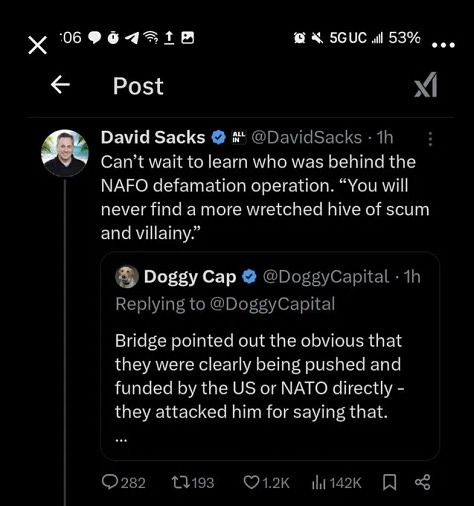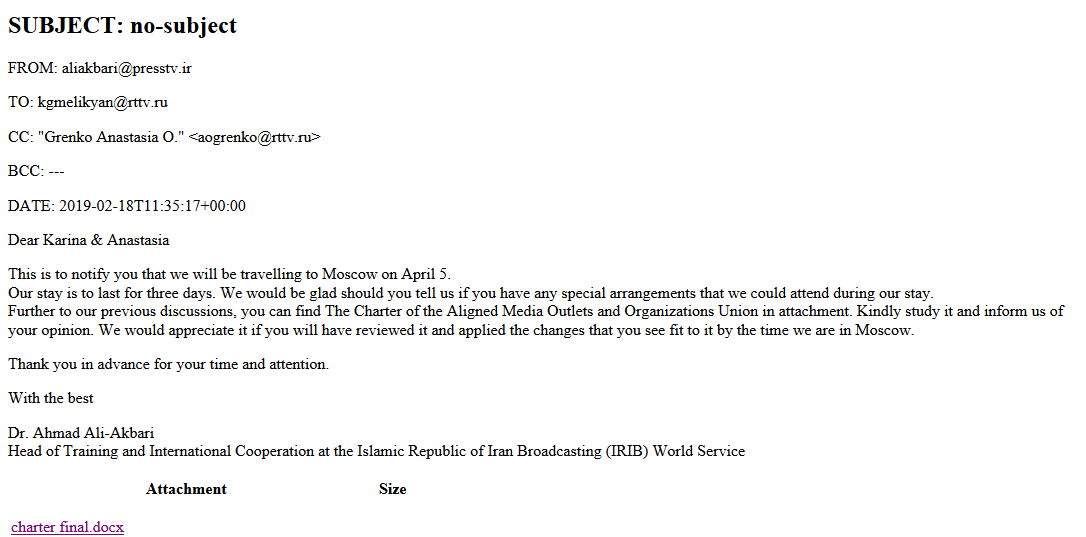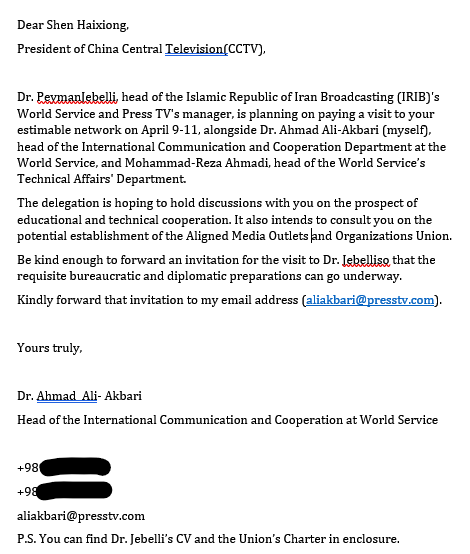The Pipeline Part 3: From Moscow to the West Wing
Russia–China–Iran’s Media Asset Inside Trump’s 2025 Administration
Leaked internal documents from PressTV – including a formal charter and an Iranian media strategy memo – reveal that the supposed “independent” alt-media ecosystem is actually an organised, multi-state information apparatus. In reality, it’s a coordinated network backed by Russia, China, Iran, and their affiliates, operating with a shared mission and playbook. Key takeaways from these documents include:
Formalised Mission: The network has an official union charter outlining its purpose to “confront biased media” and “present... various vantage points” as a counter to Western media dominance. In plain terms, the member outlets agreed to promote an “alternative narrative” to what they deem Western media hegemony – a classic Kremlin/Tehran/Beijing framing. The charter explicitly calls for “aligning and reinforcing common positions vis-à-vis momentous international developments”, meaning editorial lines are coordinated across countries, not spontaneous. The content priorities skew toward anti-NATO, anti-U.S. military and pro-“multipolar world” themes (all hallmarks of Russian, Iranian, and Chinese state narratives).
Coordinated Structure & Membership: This is not a loose affinity group; it’s a formal coalition of state-aligned media. The charter establishes an “Aligned Media Outlets and Organizations Union” headquartered in Tehran, with an Executive Council composed of top state media chiefs. Its founding members and supporters span multiple regimes and their propaganda arms:
🇷🇺 Russia: RT (Russia Today) and Sputnik (state-run broadcasters).
🇮🇷 Iran: PressTV (state-owned English-language TV under IRIB).
🇨🇳 China: CCTV/CGTN (state television) and Global Times (Party-owned newspaper).
“Aligned” independents: A host of ostensibly independent websites that relentlessly echo pro-Kremlin/Tehran talking points – for example The Duran, The Saker, Unz Review – as well as their influencers (commentators like Garland Nixon, Max Blumenthal, George Galloway, etc.). The strategy memo literally lists such outlets and bloggers as part of the alliance, noting some receive direct material support from Russia and others simply toe the Kremlin line. In one excerpt, Iranian analysts enumerate sites from SouthFront and Strategic Culture to Grayzone and Zero Hedge, categorising which are openly funded vs. “aligned” with Russian narratives.
Regional partners: State-friendly outlets across Latin America, Africa, and Europe also feature, aligning with efforts like China’s Belt & Road media forums. (Indeed, many names correspond to attendees of international “media cooperation” conferences.) This indicates the network’s reach extends beyond the big three (Russia/China/Iran) to sympathetic media in dozens of countries, all coordinated to amplify the same anti-West messaging.
Operational Tactics: The documents expose a deliberate operational strategy to maximise the network’s influence:
🔄 Cross-posting and content sharing: Member outlets exchange news articles and even raw video footage to boost each other’s coverage. A story or video produced by one node (say, RT) will often be republished or rebroadcast by others (PressTV, CGTN, etc.), creating an echo effect.
⏱️ Timed release of talking points: During major events – e.g. the Ukraine invasion, Gaza conflicts, or COVID-19 – these outlets roll out synchronized narratives. The charter commits them to consult and align their positions on “momentous international developments”. In practice, when a crisis breaks, they push the same lines (for instance, “NATO provoked the Ukraine war” or “COVID measures are Western control schemes”) in near unison across multiple platforms.
🎙️ Shared “experts” and pundits: The network maintains a rotating roster of approved commentators who appear across outlets. You’ll see the same analyst on an RT segment one week, on PressTV the next, and quoted by Global Times the week after – presented as an independent expert each time. This recycling of loyal voices gives an illusion of widespread consensus. It’s a closed loop of punditry: friendly academics, former officials, or bloggers are platformed on all member channels, reinforcing each other’s credibility while staying on-script with the agreed narrative.
2️⃣ Why This is Not “Independent Media”
All of the major “nodes” in this charter are state-owned or state-controlled – hardly independent by any stretch. RT and Sputnik answer to the Kremlin, PressTV to the Iranian regime, CGTN and Global Times to the CCP. Even many of the so-called “independent” sites in the orbit are, as the leaked strategy memo reveals, anything but autonomous. The Iranian document explicitly groups Western alternative media outlets into tiers of directly funded vs. aligned with Russia. In other words, what looks like a diverse array of blogs and news sites actually operates as an extended arm of state propaganda.
Crucially, editorial lines are pre-coordinated in advance. The charter’s mandate to “reinforce common positions” means these outlets are not organically arriving at similar conclusions – they are literally part of a joint strategy. There is no true editorial independence here. When every member outlet is singing from the same sheet music, it’s clear their “narratives” are the product of agreements (or orders), not genuine investigative journalism.
Perhaps the most telling evidence is how “independent” branding is used as a facade. The strategy docs outright discuss using ostensibly independent outlets as white-label fronts to launder state narratives. For example, Iranian planners note that due to the negative image of Iran’s state media, “having a media outlet that appears independent... but reflects the majority of [our] positions can significantly help remove source bias”. In other words, if the propaganda is coming from what looks like a home-grown dissident site, Western audiences might trust it more than if it were labeled “Iranian government news.” This is a conscious tactic. Russia and China do the same – funding proxy websites and influencers in the West who push Kremlin/CCP talking points under the guise of being grassroots truth-tellers.
Far from being a spontaneous convergence of contrarian voices, this network is an influence operation by design. The charter and memos openly frame their mission as countering Western influence and shaping global opinion in a direction favourable to Moscow, Tehran, and Beijing. That is a geopolitical project, not mere shared ideology. The bottom line: when you see outlets like The Duran or personalities like those listed in the documents, you’re not seeing rogue freelancers – you’re seeing an extended propaganda arm that ultimately traces back to foreign state power.
3️⃣ Ties to Gabbard, Sacks, and RFK Jr.



The concern isn’t just theoretical. Key figures now in the U.S. government have been actively engaging with this very network, lending it legitimacy and in some cases participating in its ecosystem:
🔗 Tulsi Gabbard (Director of National Intelligence): Gabbard has interacted repeatedly with outlets and personalities from the charter network. Notably, she was a headline speaker at the February 2023 “Rage Against the War Machine” rally – an event stacked with charter-aligned media figures. Speakers at that rally alongside Gabbard included Garland Nixon (Sputnik radio host), Max Blumenthal (Grayzone founder), and other regulars from The Duran/RT orbit. Gabbard has frequently echoed similar talking points (e.g. accusing “Western elites” of warmongering) and appeared on shows of fellow travellers. She has even been praised in Russian media for her stances. In essence, the DNI – the person now overseeing U.S. intelligence – has moved in the same circles as Kremlin and Iranian propagandists and amplified their narratives. This close alignment raises obvious conflict-of-interest and security red flags.
🔗 David Sacks (“AI Tsar”/Tech Advisor): Sacks, a Silicon Valley billionaire now entrusted with guiding U.S. AI and tech policy, has blatantly promoted the charter network’s narratives. He has collaborated with and appeared on platforms of figures like The Duran. In fact, in 2024 Sacks was a featured guest on The Duran’s own podcast, where he dutifully opined that the Biden administration/NATO provoked the Ukraine war – exactly the Kremlin’s line Sacks has repeatedly argued on social media and in interviews that “Western media lies” and that Russian state media reports are more trustworthy. He often cites the same “experts” beloved by RT (such as Colonel Douglas Macgregor, etc.) to bolster the idea that Washington should cut off support to Ukraine. In short, the very person shaping America’s tech future is enmeshed in a pro-Kremlin information ecosystem – appearing on its shows, parroting its messaging, and lending it an air of credibility in U.S. policy debates.
🔗 Robert F. Kennedy Jr. (Health and Human Services Secretary): RFK Jr. has traveled in these circles as well, especially during his contrarian COVID-19 crusades. He gave numerous interviews to alternative platforms that host charter-aligned commentators, pushing themes like “the pandemic was exploited by global elites for a power grab.” Such claims closely mirror narratives on outlets like Grayzone and UNZ Review (which spent the pandemic downplaying the virus and blaming Western “elites”). As a presidential candidate in 2024, Kennedy also embraced the “NATO caused the war” narrative regarding Ukraine – a stance cheered on by Russian state media and its proxies. Many of the figures who promoted RFK Jr.’s candidacy or gave him friendly airtime (e.g. Jimmy Dore, Kim Iversen) are themselves tied into this network, often platforming the same guests from The Duran/Sputnik/PressTV. Now that RFK Jr. is heading HHS, his willingness to align with adversarial disinformation campaigns (on public health, on foreign policy) is not just a quirk – it’s a strategic vulnerability.
In all three cases, these officials are not just bystanders who consumed some alternative media in ignorance. They have actively participated in, amplified, and legitimized a foreign propaganda network. Gabbard and Sacks in particular were effectively minor celebrities within that ecosystem (appearing at its events and on its shows). Their elevation to high office essentially bridges the propaganda network right into the halls of the U.S. government.
4️⃣ Why This is a Cabinet-Level Security Issue
This goes well beyond “guilt by association.” We are looking at a foreign-coordinated influence apparatus – documented in writing – that now has allies at the highest levels of the U.S. executive branch. The leaked charter isn’t just a casual agreement; it’s a blueprint for a joint state propaganda enterprise used by Russia, China, Iran and their proxies. That enterprise:
Has a formal membership and published charter (signed off by state media heads), creating an institutionalised alliance of propaganda outlets.
Is explicitly designed to reshape Western public opinion in line with those states’ geopolitical interests. The charter’s mission of countering “unilateral” (i.e. Western) media and promoting “various vantage points” is diplomatic phrasing for information warfare. Similarly, China’s own state-media unions openly admit they serve Beijing’s foreign policy goals. In short, this network is a weapon of influence.
Now has its adherents embedded inside the U.S. chain of command. Through the new Cabinet officials (and advisors) who have been part of this network’s ecosystem, the propaganda alliance effectively gains a friendly foothold within our government.
Think of the implications. The Director of National Intelligence is someone who has echoed narratives of America’s adversaries and might discourage aggressive counterintelligence scrutiny of those very influence operations. The HHS Secretary has a record of spreading disinformation that originated from foreign sources (with real consequences for public health). A top tech/AI advisor has openly sided with authoritarian propaganda against U.S. policy. This isn’t a hypothetical risk – it’s a present national security concern.
To put it plainly: a propaganda network jointly run by Moscow, Beijing, and Tehran is no longer just trying to influence Washington from the outside – it now has sympathetic partners on the inside of Washington’s own decision-making team.
⚠️ This represents a profound security breach, one that blurs the line between foreign influence and domestic policy to an unprecedented degree. The charters and strategy docs exposed the network’s goals; the latest appointments raise the alarm that those goals might find traction within the U.S. government itself. In other words, a hostile information campaign has potentially gained a seat at the table – a scenario that demands urgent scrutiny and action from America’s security community
💣 Coming in Part 4: From Words to Weapons
The charter and strategy docs show us the blueprint. In the next part, we’ll see the execution — how this same Russia–China–Iran media network didn’t just push talking points, but actively covered for, coordinated with, and amplified hybrid attacks on Western soil.
🔍 We’ll follow the trail from the assassination of Israeli nationals in the U.S., to sabotage of NATO-linked infrastructure in the UK and Belgium — and show how the state run “alternative media” ecosystem provided both narrative camouflage and real-time operational support.
If Part 3 was about influence in Washington…
⚠️ Part 4 is about influence turning kinetic - to be released on the day Donald Trump will meet the person behind this network in Alaska.
All subscriptions are donated to Ukrainian causes. Full english and farsi documents are available below.
Keep reading with a 7-day free trial
Subscribe to The Angry Dogs to keep reading this post and get 7 days of free access to the full post archives.





